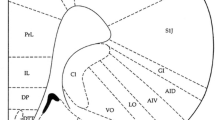Abstract
Rationale
Placebos are known to induce analgesia through the activation of μ-opioid receptors in some circumstances, such as after morphine pre-conditioning, an effect that is blocked by opioid antagonists.
Objectives
On the basis of the anti-opioid action of cholecystokinin, here we tested whether the activation of the cholecystokinin type-2 receptors abolishes opioid-induced placebo responses.
Methods
The activation of the cholecystokinin type-2 receptors was performed by means of the agonist pentagastrin, and placebo responses were obtained after morphine pre-conditioning in an experimental human model of pain (tourniquet technique).
Results
Opioid-induced placebo responses were completely disrupted by pentagastrin administration. In addition, a high correlation between the response to morphine and the response to placebo was found, and this correlation was completely abolished by pentagastrin.
Conclusion
These results show that the cholecystokinin-2 receptor agonist, pentagastrin, has the same effect as the μ-opioid receptor antagonist, naloxone, on placebo analgesia induced by morphine pre-conditioning, which suggests that the balance between cholecystokinergic and opioidergic systems is crucial in placebo responsiveness in pain. These findings also suggest that cholecystokinin type-2 receptor hyperactivity might be present in placebo non-responders.


Similar content being viewed by others
References
Amanzio M, Benedetti F (1999) Neuropharmacological dissection of placebo analgesia: expectation-activated opioid systems versus conditioning-activated specific subsystems. J Neurosci 19:484–494
Andre J, Zeau B, Pohl M, Cesselin F, Benoliel JJ, Becker C (2005) Involvement of cholecystokininergic system in anxiety-induced hyperalgesia in male rats: behavioral and biochemilac studies. J Neurosci 25:7896–7904
Benedetti F (2008) Mechanisms of placebo and placebo-related effects across diseases and treatments. Annu Rev Pharmacol Toxicol 48:33–60
Benedetti F, Amanzio M, Maggi G (1995) Potentiation of placebo analgesia by proglumide. Lancet 346:1231
Benedetti F, Amanzio M, Casadio C, Oliaro A, Maggi G (1997) Blockade of nocebo hyperalgesia by the cholecystokinin antagonist proglumide. Pain 71:135–140
Benedetti F, Amanzio M, Vighetti S, Asteggiano G (2006) The biochemical and neuroendocrine bases of the hyperalgesic nocebo effect. J Neurosci 26:12014–12022
Benedetti F, Pollo A, Colloca L (2007) Opioid-mediated placebo responses boost pain endurance and physical performance—is it doping in sport competitions? J Neurosci 27:11934–11939
de la Fuente-Fernandez R, Ruth TJ, Sossi V, Schulzer M, Calne DB, Stoessl AJ (2001) Expectation and dopamine release: mechanisms of the placebo effect in Parkinson’s disease. Science 293:1164–1166
Eippert F, Bingel U, Schoell ED, Yacubian J, Klinger R, Lorenz J, Büchel C (2009a) Activation of the opioidergic descending pain control system underlies placebo analgesia. Neuron 63:33–43
Eippert F, Finsterbusch J, Bingel U, Büchel C (2009b) Direct evidence for spinal cord involvement in placebo analgesia. Science 326:404
Enck P, Benedetti F, Schedlowski M (2008) New insights into the placebo and nocebo responses. Neuron 59:195–206
Finniss DG, Kaptchuk TJ, Miller F, Benedetti F (2010) Biological, clinical, and ethical advances of placebo effects. Lancet 375:686–695
Gospic K, Gunnarsson T, Fransson P, Ingvar M, Lindefors N, Petrovic P (2008) Emotional perception modulated by an opioid and a cholecystokinin agonist. Psychopharmacology 197:295–307
Guo J-Y, Wang J-Y, Luo F (2009) Dissection of placebo analgesia in mice: the conditions for activation of opioid and non-opioid systems. J Psychopharmacol (in press)
Hebb ALO, Poulin J-F, Roach SP, Zacharko RM, Drolet G (2005) Cholecystokinin and endogenous opioid peptides: interactive influence on pain, cognition, and emotion. Prog Neuro Psychopharmacol Biol Psychiatry 29:1225–1238
Levine JD, Gordon NC, Fields HL (1978) The mechanisms of placebo analgesia. Lancet 2:654–657
Petrovic P, Kalso E, Petersson KM, Ingvar M (2002) Placebo and opioid analgesia—imaging a shared neuronal network. Science 295:1737–1740
Price DD, Finniss DG, Benedetti F (2008) A comprehensive review of the placebo effect: recent advances and current thought. Annu Rev Psychol 59:565–590
Scott DJ, Stohler CS, Egnatuk CM, Wang H, Koeppe RA, Zubieta JK (2007) Individual differences in reward responding explain placebo-induced expectations and effects. Neuron 55:325–336
Scott DJ, Stohler CS, Egnatuk CM, Wang H, Koeppe RA, Zubieta JK (2008) Placebo and nocebo effects are defined by opposite opioid and dopaminergic responses. Arch Gen Psychiatry 65:1225–1226
Wager TD, Billing JK, Smith EE, Sokolik A, Casey KL, Davidson RJ, Kosslyn KL, Rose RM, Cohen JD (2004) Placebo-induced changes in fMRI in the anticipation and experience of pain. Science 303:1162–1166
Wager TD, Scott DJ, Zubieta JK (2007) Placebo effects on human μ-opioid activity during pain. Proc Nat Acad Sci USA 104:11056–11061
Zubieta JK, Bueller JA, Jackson LR, Scott DJ, Xu Y, Koeppe RA, Nichols TE, Stohler CS (2005) Placebo effects mediated by endogenous opioid activity on μ-opioid receptors. J Neurosci 25:7754–7762
Acknowledgments
This work was supported by grants from the Istituto San Paolo di Torino and the Regione Piemonte (Turin, Italy) and from the Volkswagen Foundation (Hannover, Germany). The experiments of the present study comply with the current laws of the country in which they were performed (Italy).
Conflicts of interest
The authors have no conflicts of interest.
Author information
Authors and Affiliations
Corresponding author
Rights and permissions
About this article
Cite this article
Benedetti, F., Amanzio, M. & Thoen, W. Disruption of opioid-induced placebo responses by activation of cholecystokinin type-2 receptors. Psychopharmacology 213, 791–797 (2011). https://doi.org/10.1007/s00213-010-2037-y
Received:
Accepted:
Published:
Issue Date:
DOI: https://doi.org/10.1007/s00213-010-2037-y




